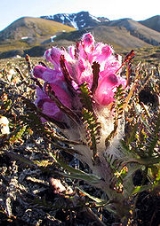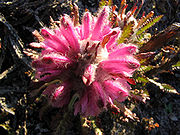
Pedicularis dasyantha
Encyclopedia
Pedicularis dasyantha (woolly lousewort or arctic hairy lousewort) is a plant native to the high arctic
areas of Svalbard
, Spitsbergen
, Novaya Zemlya
, and the Jamal Peninsula of Siberia
.
It grows to 10–15 cm tall, with a stout stem, single or a few together, from a thick, yellow taproot
. The basal leaves
are numerous and pinnately divided into many remote segments. The stem has many leaves, woolly in the uppermost part between the flower
s. The flowers are produced in a dense oblong inflorescence, each flower with a red corolla, with the upper tip hairy; the corolla tube is longer than the calyx
.
It grows in moist places and on heaths.

Arctic
The Arctic is a region located at the northern-most part of the Earth. The Arctic consists of the Arctic Ocean and parts of Canada, Russia, Greenland, the United States, Norway, Sweden, Finland, and Iceland. The Arctic region consists of a vast, ice-covered ocean, surrounded by treeless permafrost...
areas of Svalbard
Svalbard
Svalbard is an archipelago in the Arctic, constituting the northernmost part of Norway. It is located north of mainland Europe, midway between mainland Norway and the North Pole. The group of islands range from 74° to 81° north latitude , and from 10° to 35° east longitude. Spitsbergen is the...
, Spitsbergen
Spitsbergen
Spitsbergen is the largest and only permanently populated island of the Svalbard archipelago in Norway. Constituting the western-most bulk of the archipelago, it borders the Arctic Ocean, the Norwegian Sea and the Greenland Sea...
, Novaya Zemlya
Novaya Zemlya
Novaya Zemlya , also known in Dutch as Nova Zembla and in Norwegian as , is an archipelago in the Arctic Ocean in the north of Russia and the extreme northeast of Europe, the easternmost point of Europe lying at Cape Flissingsky on the northern island...
, and the Jamal Peninsula of Siberia
Siberia
Siberia is an extensive region constituting almost all of Northern Asia. Comprising the central and eastern portion of the Russian Federation, it was part of the Soviet Union from its beginning, as its predecessor states, the Tsardom of Russia and the Russian Empire, conquered it during the 16th...
.
It grows to 10–15 cm tall, with a stout stem, single or a few together, from a thick, yellow taproot
Taproot
A taproot is an enlarged, somewhat straight to tapering plant root that grows vertically downward. It forms a center from which other roots sprout laterally.Plants with taproots are difficult to transplant...
. The basal leaves
Leaf
A leaf is an organ of a vascular plant, as defined in botanical terms, and in particular in plant morphology. Foliage is a mass noun that refers to leaves as a feature of plants....
are numerous and pinnately divided into many remote segments. The stem has many leaves, woolly in the uppermost part between the flower
Flower
A flower, sometimes known as a bloom or blossom, is the reproductive structure found in flowering plants . The biological function of a flower is to effect reproduction, usually by providing a mechanism for the union of sperm with eggs...
s. The flowers are produced in a dense oblong inflorescence, each flower with a red corolla, with the upper tip hairy; the corolla tube is longer than the calyx
Sepal
A sepal is a part of the flower of angiosperms . Collectively the sepals form the calyx, which is the outermost whorl of parts that form a flower. Usually green, sepals have the typical function of protecting the petals when the flower is in bud...
.
It grows in moist places and on heaths.
See also
- Flora of SvalbardFlora of SvalbardThere are 164 vascular plant species on the Norwegian Arctic archipelago of Svalbard. This figure does not include algae, mosses, and lichens, which are non-vascular plants. For an island so far north, 164 species constitutes an astonishing variety of plant life. Because of the harsh climate and...


